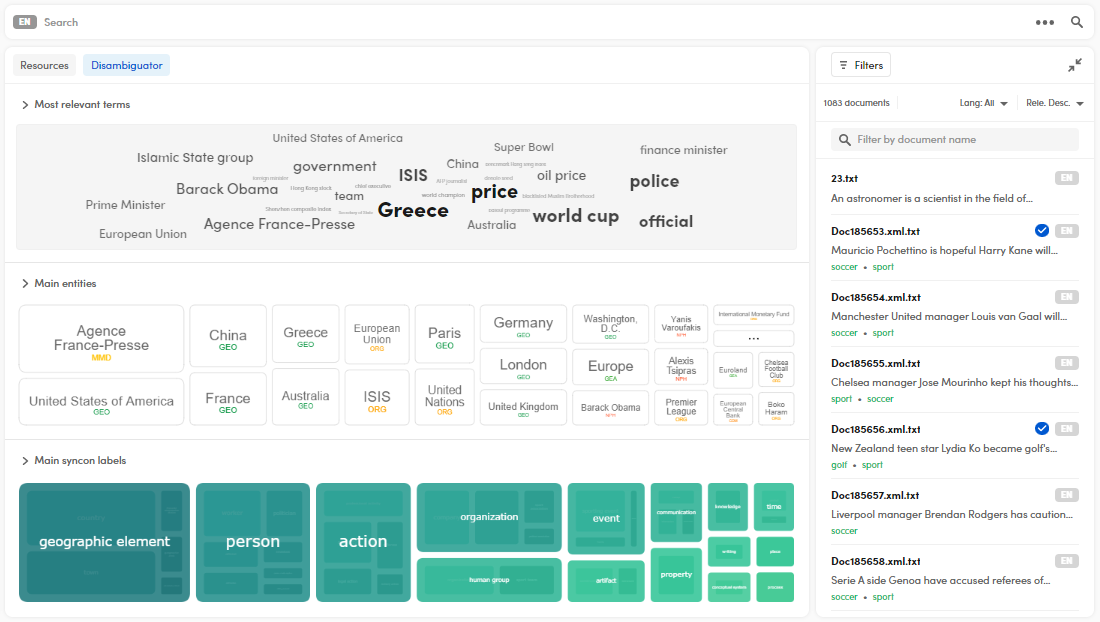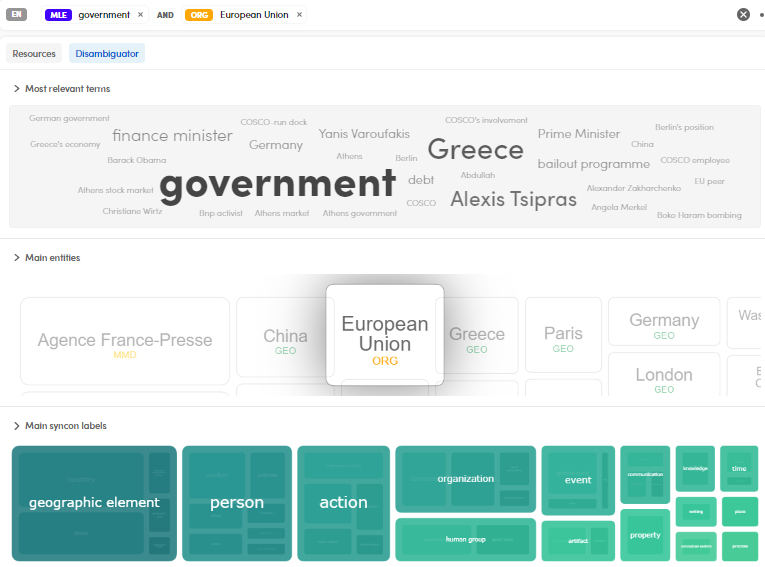Check the documents analytics
Overview
In the Analytics view it is possible to find a set of indicators regarding the library in use and to filter the documents based on their features.
Display the Analytics page
Select Analytics  to display the documents analytics.
to display the documents analytics.

Check the languages and the documents count
To check the languages status and the documents count, watch Languages in the left panel.
Check the coverage
To check the coverage status, watch the left panel and click the go on  and go back
and go back  browsing arrows to display the panel of interest.
browsing arrows to display the panel of interest.
You can find:
- n Categories: categories count (n), that is the nodes count in the taxonomy.
- Extracted categories: resulting categories after experiments.
- Annotated categories: manually annotated categories.
- Extracted documents: documents count with resulting categories after experiments.
- Annotated documents: documents count with manually annotated categories.
- Validated documents: validated documents count.
Check the main topics
To check the main topics status, watch the left panel and click the go on  and go back
and go back  browsing arrows to display the panel of interest.
browsing arrows to display the panel of interest.
You can find a graph and a list of the main topics of the selected project library with their percentages.
Double-click a topic or a slice of the graph to perform a search.
Filter annotated documents, documents containing resulting categories after the experiments and validated documents
While looking at the Coverage panel:
- To Filter the annotated documents, double-click Annotated documents.
- To Filter the resulting categories after the experiments, double-click Extracted documents.
- To Filter the validated documents, double-click Validated documents.
The resulting documents are displayed in the Relevant documents panel, Resources tab and in the Documents preview list on the right side.
Note
You can also double-click the corresponding colored lines on the chart to apply filters.
Check the top and worst categories
To check the top and worst categories and the number of annotations, watch the upper part of the Resources tab.
- Select Extractions and/or Annotations to display the resulting categories after experiments and/or the manually annotated categories.
- Use the expanding
 and collapsing arrows
and collapsing arrows  to show more or less details.
to show more or less details. - Hover over the violet line to know the number of total annotations of a category.
- Hover over the orange line to know the number of total hits of a category.
- Double-click a line to perform a search according to the category in focus.
Check the annotations vs extractions
The Annotations vs Extractions sub-panel is a bubble diagram: the y-axis represents the number of total hits of a category, the x-axis represents the number of total annotations of a category. Each bubble represents a category.
The bigger the bubble, the bigger the difference between the number of hits and annotations of that category and vice versa.
The width of the bubbles helps you understand on which category you have to work more.
- Use the expanding
 and collapsing arrows
and collapsing arrows  to show more or less details.
to show more or less details. - Hover over a bubble to find out categories hits and annotations.
- Double-click a bubble to perform searches according to the category in focus.
Check the relevant documents
The Relevant documents sub-panel lists all documents with and without annotations:
Use the expanding  and collapsing arrows
and collapsing arrows  to show more or less details.
to show more or less details.
On the left you can see the documents that contain the highest number of annotated and/or detected categories, while on the right you can see the documents that have no annotations and/or detected categories.
- Select Extractions or Annotations to display the resulting categories after experiments or the manually annotated categories.
- Select Most annotated, Not annotated (when the Annotations box is checked), Most extracted, Not extracted to apply filters.
- Select a document to open it in detail view.
Documents preview list
- To display or hide the Documents preview list, select Expand
 or Collapse
or Collapse  on the right side.
on the right side. - To filter documents according to their annotations, categories, validations and entities, select Filters
 .
. -
To open a document in detail view:
- Double-click it.
Or:
- Select its name.
-
To sort documents by relevance, select the option from the drop-down menu.
- To filter documents by language, select the option from the language drop-down menu.
- To look for a specific document, use the search bar (minimum three characters).
Display main relevant terms, main entities and main syncons
To display the most relevant terms, select the Disambiguator tab. All the features in this tab are already described in the corpora section of this manual.

Filter documents according to Most relevant terms, Main entities and Main syncons
To filter documents according to main relevant terms, main entities and main syncons, double-click the related items of your interest.
Example
If you want to filter the documents that contain the value government as most relevant terms and European Union as main entity:
- Double-click government in the Most relevant terms panel
- Double-click European Union in the Main entities panel.

The related chips are displayed in the search bar.
You can click a single entity of the Main syncon labels panel—after expanding it—to enlarge its box and view the inner entities inside a syncon.